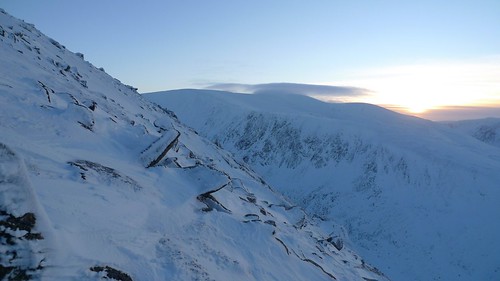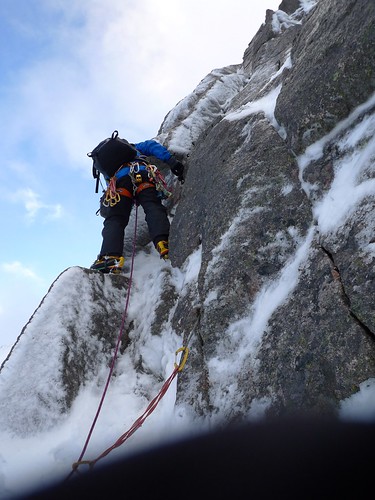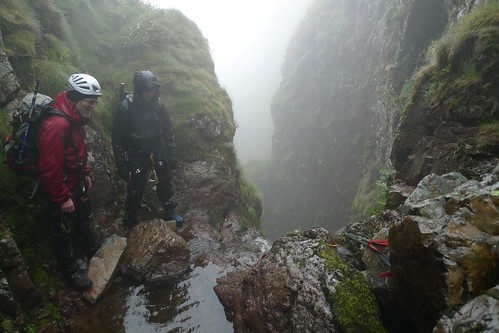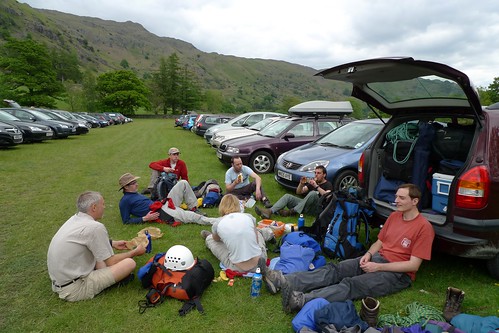An Introduction to Winter Lead Climbing at Glenmore Lodge
I wish that I hadn’t taken the overnight coach
I thought on the walk into Coire an t-Sneachda. Maybe in hindsight it wasn’t such a good idea to go by a method of transport that guarantees an interrupted, uncomfortable night without the benefit of anasthetic. Maybe going for a week of winter climbing in the Cairngorms with a niggling ankle injury wasn’t the greatest of ideas either.
Pushing those thoughts aside I pushed on diagonally up the snow slope, unsteadily trying to keep pace without slipping or impaling myself on my own crampons. A few helpful tips on how to improve my footwork from our instructor (Mike) later and I’d made it to the beginning of the day.
Still a little shaken, I followed Mike up Hidden Chimney Direct Start. Having never climbed anything harder than grade II before, jumping straight into grade IV was a bit of a shock to the system! Some inventive moves with my borrowed axes were needed – yes you can jam your hammer into a crack, but only if you can live with having the pick pointing straight at you when you make the next move. First pitch over without mishap my fellow instructee, also confusingly called Mike, lead the much easier second pitch. As I was standing around in the cold for the duration, I started the lengthy process of extracting a flapjack from its wrapper whilst wearing mittens. An eternity later I took my first bite: seconds later a lump of ice knocked it straight out of my hand.
Finally – time to climb again. I moved up to where Mike and Mike were waiting before leading through to the top, Mike (the instructor) happly soloing ahead and either finding or placing gear up ahead. As we got further up the protection got even sparser so that as I traversed below the cornice that signalled the end the plan became: just don’t fall off
. As I cleared the cornice I came to an abrupt halt as I reached the end of the rope. Luckily Mike had the other rope and was able to set up a snow bollard and a bucket seat as I struggled to move into a safer position. Some revision on how to body belay later, Mike made it to the top.
After an action-packed first day, we followed it up the next day with a long walk through Charlamain Gap to Lurcher’s Crag. The 1.5hr walk in took a whole 2.5hrs but when we got to the base of North Gully it was worth it as there was loads of lovely water ice. As I’d got a different pair of axes out of stores I was enjoying the benefits of clipper leashes (no axes dangling from my wrists when trying to place protection for example). We even had some sunshine! After walking out in the dark we made it back to the lodge in time to bring the remains of the scheduled tea and cake into the evening lecture.
Lectures in the evening were all on useful topics like how to avoid getting avalanched, how to navigate when you can’t see, and what to do if you fail to avoid being avalanched. At the end of each lecture it was easy to see who was on a climbing course as we were the ones having difficulty unfolding ourselves afterwards.
Wednesday we climbed with the other group on the leading course (to make things less confusing both fellow students were called David), and we spend a pleasent day scittering around on a mainly rock route and getting used to placing our own protection. Now for those of you who’ve only climbed in summer – it’s a bit more involved that just finding the right sized nut to fit in the likely looking crack. First step is to clear away the snow in order to find the crack in the first place. Next you have to scrape the ice away from inside the crack. Then you try to place a #3 nut – it fits! Not so fast – lets just ckeck that all the ice has been removed. Some more scraping and you find out that crack is actually large enough for a #6! Now to make sure that it’s well seated – you hit it with your pick until the nut is completely misshapen. Rinse and repeat.
By Thursday there had been a bit of a thaw. So as we climbed up Goat Track Gully there was meltwater in addition to the rain streaming down the rock, down the ropes and then onto the belayer. Valuable lessons were learnt like:
- waterproof gloves aren’t;
- belay jackets only work if you wear them;
- wearing gaiters over your trousers funnels water down your legs into your boots;
- a spare pair of dry mittens are fantastic.
On the last day we focussed more on new skills like placing pitons (not easy if your borrowed axes have extremely bent shafts), revised some older ones like snow belays, and had a bit of coaching on technique when climbing on ice. My ankle decided to tell me that enough was enough on the walk out – but it had made it through the rest of the week.
An absolutely fantastic week. Well to be recommended. Also recommended is the Caledonian Sleeper that I took on the way back.
More photos from the trip are available here.






